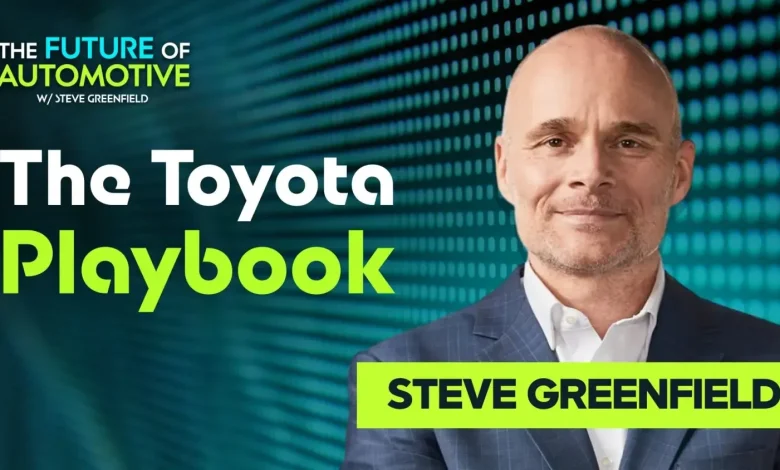Toyota proves patience pays with its hybrid-focused strategy

Welcome back to the latest episode of “The Future of Automotive” on CBT News, where we put recent automotive and mobility news into the context of the broader themes impacting the industry.
I’m Steve Greenfield from Automotive Ventures, and I’m glad that you could join us.
This week, on The Future of Automotive, we’re taking a closer look at the EV slowdown—and why Toyota, a company once criticized for dragging its feet on fully electric vehicles, now appears to be the unexpected voice of reason in the industry. Some might say they’ve ended up looking like the smartest person in the room.
Earlier in the decade, Toyota took a lot of heat for being ‘too slow’—too cautious—when it came to all-electric cars. Instead of plowing headfirst into battery-electric development, the company doubled down on something far less flashy: hybrids. And as the industry now confronts softening demand and supply-chain constraints, it’s clear that Toyota’s bet wasn’t just conservative—it was strategic.
Sign up for CBT News’ daily newsletter and get the latest industry stories delivered straight to your inbox.
Many of our viewers may have heard of Toyota’s ‘1-6-90 rule.’ It’s a simple but striking piece of math: the raw materials needed to build one long-range electric vehicle could instead produce six plug-in hybrids—or ninety traditional hybrids. For Toyota, that ratio isn’t just an engineering curiosity. It’s the backbone of a philosophy that argues the fastest path to cutting carbon emissions worldwide isn’t a single technology, but a diversified mix—one that makes the most of limited battery resources.
And there’s something else Toyota has done right: consistency. While other automakers swung hard toward EVs and are now retrenching, Toyota stuck to its multipath strategy. In the U.S., that means steady progress on EVs, but also an aggressive expansion of hybrid and plug-in hybrid options across the lineup.
Another point often overlooked: the company’s relationship with its dealers. Toyota didn’t overbuild its retail network, and the result is one of the strongest, most profitable dealer bodies in the country. Each franchise sells more vehicles, and in turn, has been better equipped to weather market shifts than many of its competitors.
By staying the course—by refusing to chase headlines or short-term sentiment—Toyota has quietly gained market share, particularly from automakers that were slow to offer hybrids and are now scrambling to adjust. And as EV demand levels off, Toyota finds itself with a broad portfolio, robust U.S. production, and products that consumers are still lining up for.
Looking back, the automaker that was once dismissed for lagging behind might just have been pacing itself. And as the rest of the industry regroups, Toyota’s deliberate strategy is starting to look less like caution—and more like keen foresight.
So, with that, let’s transition to Our Companies to Watch.
Every week, we highlight an interesting company in the automotive technology space to keep an eye on. If you read my weekly Intel Report, we showcase a company to watch, and we then take the opportunity here on this segment each week to share that company with you.
Today, our new company to watch is SelectFI.
SelectFi is a a predictive lending AI software tool for delaers that allows them to pencil more accurate, profitable payments from their lenders with no credit impact to their consumers.
The SelectFI® Lender Selector® product is a pre-desking solution that leverages an intuitive process for dealership sales and BDC teams.
With a minor change to your current customer discovery process, dealers can build deals with better information from the SelectFi AI, enabling your desking team to improve closing rates, create faster, more accurate first pencils, and achieve greater regulatory compliance.
The SelectFi Lender Selector® product uses Predictive Lending™ to help dealerships quickly and accurately estimate automotive financing for customers, allowing for greater compliance with FTC fair lending regulations.
If you’d like to learn more about SelectFi, you can check them out at www.SelectFi.com
So that’s it for this week’s Future of Automotive segment.
If you’re an entrepreneur looking to solve a big problem anywhere across the Mobility spectrum, we want to hear from you. We are actively investing out of our new Mobility Fund.
Don’t forget to check out my first book, “The Future of Automotive Retail,” and my newest book, “The Future of Mobility”, both of which are available on Amazon.
Thanks (as always) for your ongoing support and for tuning into CBT News for this week’s Future of Automotive segment. We’ll see you next week!





